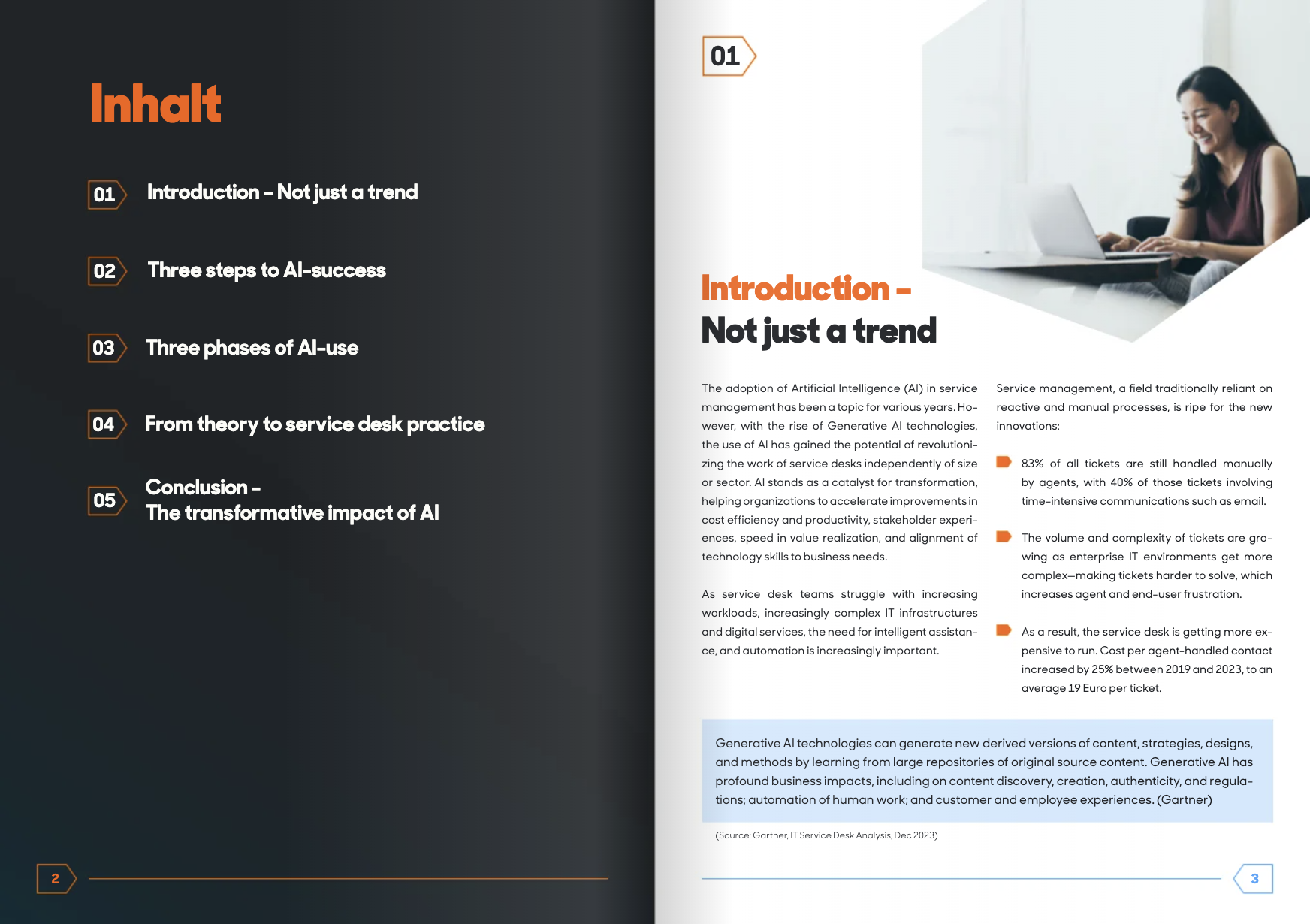How to start with AI in Service Management
Helping service desk teams and end-users to work smarter and solve issues quicker at a lower cost of service.
This whitepaper shows you
-
typical use-cases
-
advantages that arise from AI
-
how to get started with your organization

What does AI mean for Service Management?
The adoption of Artificial Intelligence (AI) in Service Management has been a topic for various years. However, with the rise of Generative AI technologies, the use of AI has gained the potential of revolutionizing the work of Service Desks independently of size or sector, especially in areas where human-computer interaction and language understanding are critical.
In the context of service management, AI can help either the end-users directly or by helping support teams work more efficiently.
When we meet different Service Desk and IT teams, they are consistently tackling similar problems:
- IT support workloads are increasing.
- The complexity of contacts to the Service Desk is rising.
- Infrastructure and the number of services are growing, along with the dependencies between them.
So the job of the IT Support team is getting harder by the day. Work at the Service Desk is largely communication-based, and years of automation haven't significantly changed this. Based on Gartner, over 80 percent of all requests and tickets are still handled 'manually' by agents. Furthermore, based on our experience in European markets, 40 percent of these are managed via more labor-intensive channels such as phone calls and emails. So the teams are looking for automation, but the issues are complex.
As Service Desk teams struggle with increasing workloads, increasingly complex IT infrastructures and digital services, the need for intelligent assistance, and automation is increasingly important. Service management, a field traditionally reliant on reactive and manual processes, is ripe for the new innovations:
of tickets are still handled manually
increase in ticket handling costs from 2019-2023
average cost per agent-handled ticket
Why now?
AI has been around for quite a while. In fact, we were even aware of the possibilities since the last century, but it did not see as much success like it does now.
- With recent tools storing more and more information, we have an abundance of data we can use to simply draw conclusions from. In addition, with a lot of applications being cloud-based, it is easier than ever to collect data about anything and everything.
- Our computational capacity has increased immensely - CPUs have been getting faster and faster, year on year, meaning that the amount of computation is on a completely different level to what was possible in the past.
- There has been more research going in this field, which means that better algorithms across various domains were developed. As technology, computational power, and datasets have improved over time, so too has the prominence and effectiveness of AI.
This is certainly the time to use all of these resources to help push productivity and experience forward across industries in the service management space.
3 Typical use-cases for AI in Service Management
Chat / Email automation
Using Artificial Intellicenge to automate responses can lead to quick efficiency gains and frees up resources for complex tasks. At it's best, AI can maintain high user satisfaction by generating accurate, contextual and personalized responses. By focusing on chat / email automation first, organizations can quickly enhance operational efficiency, gain immediate insights into AI's impact, and set the stage for the next steps in their AI journey in service management.
AI-amplified service desk
Integrating AI deeper into the Service Desk work done by agents can increase productivity even for the more complex issues without compromising service quality for the end-user. In practice this means empowering agents with tools that streamline ticket handling via e.g. intelligent categorization, suggestions, and summarization; which all help reduce manual work.
AI support for end-users
Intelligent self-service options can reduce the reliance on manual agent interaction for routine queries. Building on the foundation set by integrating AI to enhance agent efficiency, extending AI's benefits directly to end-users is another use-case in the AI journey. This shift not only addresses the increasing complexity and volume of service requests but also aligns with the growing user preference for self-service solutions. The introduction of AI-powered tools for end-users marks a critical step in transforming service management into a more autonomous, user-friendly ecosystem.
How to start using AI in your Service Desk?
Launching AI within a service management ecosystem is a strategic process, rooted in careful analysis and planning. The process begins by understanding the current service management related needs and identifying how AI can best be leveraged to address them. Here are key steps we have seen in successful AI deployments:
Step 1: Analyze your current support processes
The key to success with AI is to find an area where it will deliver the most business value in the shortest space of time, with the least amount of business disruption. You don’t have to transform the whole Service Desk at once—it’s much better to start with a quick but valuable win.
Step 2: Identify the biggest bottlenecks and inefficiencies
Somewhere within the case lifecycle there will be bottlenecks that slow your agents down and frustrate your users. In a typical organization, those bottlenecks might include:
- Tickets wait in a queue for classification, slowing down the time it takes to get a suitable agent assigned.>
- Agents are assigned too many tickets in a day, creating stress, delaying resolutions for users, and potentially reducing the quality of agent-user communications.
- Agents spend a lot of time writing emails to users, either asking for clarifications or providing solutions. Finding the right language for non-technical users can slow agents down further.
- Time spent documenting ticket resolutions takes agents away from solving users’ problems. While it’s necessary for the knowledge base, it can affect the user experience.
Identifying these bottlenecks in your own Service Desk will give you a good idea of where to focus your first AI implementation. They can be found by examining reports and by interviewing agents to collect qualitative data around their day-to-day experience. Talking to agents can also help to reassure them that AI won’t put their job at risk, but will just help them to work smarter.
Step 3: Pick a first use case for an AI pilot project
From the bottlenecks you’ve identified, pick one area where you think the introduction of AI will deliver the most business value with the least disruption to Service Desk operations. This will become the first ‘quick win’ to prove the value of AI and get agents used to having a digital assistant.
The area you choose will depend on your business, but we’ve found that email can be a really good place to start. For a start, the business value is high: in our experience, around 40% of manually-handled tickets involve time-consuming use of email, so an AI assistant can unlock efficiencies very quickly.
Step 4: Iterate and Improve
Based on performance metrics, user feedback, and evolving business needs, iterate and improve the AI solution over time. Incorporate new use-cases, and optimizations to maximize the value of AI in your service desk and ensure ongoing success.
Introducing AI gradually into the Service Desk means you can score quick wins in terms of efficiency and productivity without overwhelming agents with new functionality.

